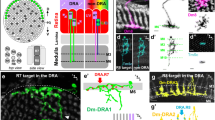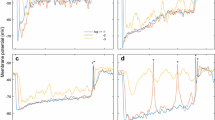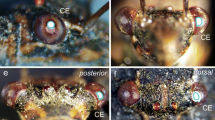Summary
Each visual unit (ommatidium) of the compound eye of the honey bee contains nine retinula cells, six of which end as axons in the first synaptic ganglion, the lamina, and three in the second optic ganglion, the medulla. A technique allowing light- and electron microscopy to be performed on the same silver-impregnated sections has made it possible to follow all types of retinula axons of one ommatidium to their terminals in order to study the shape of the terminal branches with their position in the cartridge.
-
1.
The axons of retinula cells 1–6 (numbered according to Menzel and Snyder, 1974) end as three different types of short visual fibres (svf) in the lamina; the axons of retinula cells 7–9 run through the lamina to terminate in the medulla and are known as long visual fibres (lvf). Retinula cells of each type are identified by the location of their cell bodies and by the direction of their microvilli. The retinula cells 1 and 4 (group I according to Gribakin, 1967) end as svf type 1 with three tassel-like branches in stratum B of the first synaptic region. The pair of cells 3, 6 and the pair 2, 5 (group II) end in the first synaptic region in stratum A. Cells 3 and 6 have forked endings, svf type 2, whereas cells 2 and 5 have tapered endings, svf type 3. The remaining retinula cells 7, 8 and 9 have long fibres. Nos. 7 and 8 (group III) have tapered endings and are termed lvf types 1 and 2, respectively. The 9th cell is the lvf type 3 with a highly branched ending.
-
2.
The nine axons in the bundle from one ommatidium have relative positions which do not change from the proximal retina to the monopolar cell body layer.
-
3.
By following silver-stained retinula cells and their corresponding axons, it is possible to describe mirror-image arrangements of fibres in the axon bundles in different parts of the eye.
This correlation of numbered retinula cells with specific axon types, together with the highly organized pattern in an axon bundle, allows the correlation between histological and physiological findings on polarization and colour perception.
Similar content being viewed by others
References
Autrum, H.J., Zwehl, V. v.: Spektrale Empfindlichkeit einzelner Sehzellen des Bienenauges. Z. vergl. Physiol. 48, 357–384 (1964)
Braitenberg, V.: Patterns of projection in the visual system of the fly. 1. Retina-lamina projections. Exp. Brain Res. 3, 271–298 (1966)
Daumer, K.: Reizmetrische Untersuchungen des Farbensehens der Biene. Z. vergl. Physiol. 38, 418–478 (1956)
Dietrich, W.: Die Facettenaugen der Dipteren. Z. Zool. 92, 465–539 (1909)
Frisch, K.v.: Tanzsprache und Orientierung der Bienen. Berlin-Heidelberg-New York: Springer 1965
Gribakin, F.G.: The types of photoreceptor cells of the compound eye of the honeybee worker as revealed by electron microscopy. (Russian). Tsitologia 9, 1276 (1967b)
Gribakin, F.G.: Cellular basis of colour vision in the honey bee. Nature (Lond.) 223, 639–641 (1969)
Gribakin, F.G.: The distribution of the long wave photoreceptors in the compound eye of the honey bee as revealed by selective osmic staining. Vision Res. 12, 1225–1230 (1972)
Grundler, O.J.: Elektronenoptische Untersuchungen am Auge der Honigbiene (Apis mellifera). I. Untersuchungen zur Morphologie und Anordnung der neun Retinulazellen in Ommatidien verschiedener Augenbereiche und zur Perzeption linear polarisierten Lichtes. Cytobiol. 9, 203–220 (1974)
Heiversen, O.v.: Zur spektralen Unterschiedsempfindlichkeit der Honigbiene. J. comp. Physiol. 80, 439–472 (1972)
Horridge, G.A., Meinertzhagen, I.A.: The exact neural projection of the visual fields upon the first and second ganglia of the insect eye. Z. vergl. Physiol. 66, 369–378 (1970a)
Meinertzhagen, I.A.: The first and second neural projections of the insect eye. Ph.D. Thesis, University of St. Andrews (1971)
Menzel, R.: Untersuchungen zum Erlernen von Spektralfarben durch die Honigbiene Apis mellifica. Z. vergl. Physiol. 56, 22–62 (1967)
Menzel, R., Snyder, A.W.: Polarized light detection in the bee, Apis mellifera. J. comp. Physiol. 88, 247–270 (1974)
Perrelet, A.: The fine structure of the retina of the honey bee drone. Z. Zellforsch. 108, 530–562 (1970)
Perrelet, A., Baumann, F.: Presence of three small retinula cells in the ommatidium of the honey bee drone eye. J. Microscopie 8, 497–502 (1969)
Phillips, E.F.: Structure and development of the compound eye of the honey bee. Proc. Acad. Nat. Sci. (Philad.) 57, 123–157 (1905)
Ribi, W.A.: Neurons in the first synaptic region of the bee, Apis mellifera. Cell Tiss. Res. 148, 277–286 (1974)
Ribi, W.A.: The neurons of the first optic ganglion of the bee, Apis mellifera. Advanc. Anat. 50, 4 (1975a)
Ribi, W.A.: Golgi studies of the first optic ganglion of the ant Cataglyphis bicolor. Cell Tiss. Res. 160, 207–217 (1975b)
Ribi, W.A.: A Golgi-EM method for insect nervous tissue. Stain Technol. (in press)
Snyder, A.W., Menzel, R., Laughlin, S.B.: Structure and function of the fused rhabdom. J. comp. Physiol. 87, 99–135(1973)
Sommer, E. W., Wehner, R.: The retina-lamina-projection in the visual system of the bee, Apis mellifera. Cell Tiss. Res. in press (1975)
Author information
Authors and Affiliations
Rights and permissions
About this article
Cite this article
Ribi, W.A. The first optic ganglion of the bee. Cell Tissue Res. 165, 103–111 (1975). https://doi.org/10.1007/BF00222803
Received:
Issue Date:
DOI: https://doi.org/10.1007/BF00222803




